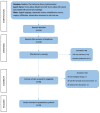Treatment, Diagnostic Criteria and Variability of Terminology for Lateral Elbow Pain: Findings from an Overview of Systematic Reviews
- PMID: 35742152
- PMCID: PMC9222841
- DOI: 10.3390/healthcare10061095
Treatment, Diagnostic Criteria and Variability of Terminology for Lateral Elbow Pain: Findings from an Overview of Systematic Reviews
Abstract
Background: Lateral elbow pain (LEP) represents a musculoskeletal disorder affecting the epicondyloid region of the elbow. The terminological framework of this problem in literature, to date, is confusing. This systematic review (SR) aims to analyse the panorama of the scientific literature concerning the pathogenetic framework, treatment, and clinical diagnosis of LEP. Methods: We conducted an SR according to the guidelines of the PRISMA statement. We performed research using the electronic Medline, Epistemonikos, and Cochrane Library databases. The research started on 12 January 2022 and finished on 30 April 2022. We included all systematic reviews and meta-analyses published, in English, between 1989 and 2022. The articles’ selection was based on critical appraisal using Amstar 2. In the selected reviews we obtained the etiopathogenic terminology used to describe the symptoms, treatment, and diagnostic criteria of LEP. Results: Twenty-five SRs met the eligibility criteria and were included in the study. From these SRs, 227 RCT articles were analysed and different treatments proposals were extracted, such as exercise, manipulation corticosteroid injection, and surgery. In the selected articles, 10 different terms emerged to describe LEP and 12 different clinical tests. The most common treatments detected in this SR were a conservative multimodal approach (e.g., eccentric exercises, manual therapy, acupuncture, ultrasound), then surgery or other invasive treatments (e.g., corticosteroid injection, tenotomy). The most common term detected in this SR was “lateral epicondylitis” (n = 95, 51.6%), followed by “tennis elbow” (n = 51, 28.1%) and “lateral epicondylalgia” (n = 18, 9.4%). Among the diagnostic tests were painful palpation (n = 101, 46.8%), the Cozen test (n = 91, 42.1%), the pain-free grip-strength test (n = 41, 19.0%), and the Maudsley test (n = 48, 22.2%). A total of 43.1% of RCTs (n = 96) included subjects with LEP > 3 months, 40.2% (n = 85) included patients with LEP < 3 months, and 16.7% of the items (n = 35) were not specified by the inclusion criteria on the onset of symptoms. Conclusions: In this SR, a considerable terminological heterogeneity emerged in the description of LEP, associated with the lack of clear and recognised diagnostic criteria in evaluating and treating patients with lateral elbow pain.
Keywords: diagnosis; lateral elbow tendinopathy; lateral epicondylitis; tennis elbow; treatment.
Conflict of interest statement
The authors declare no conflict of interest.
Figures




References
-
- Verhaar J.A. Tennis elbow. Anatomical, epidemiological and therapeutic aspects. Int. Orthop. 1994;18:263–267. - PubMed
Publication types
LinkOut - more resources
Full Text Sources
Research Materials
Miscellaneous

